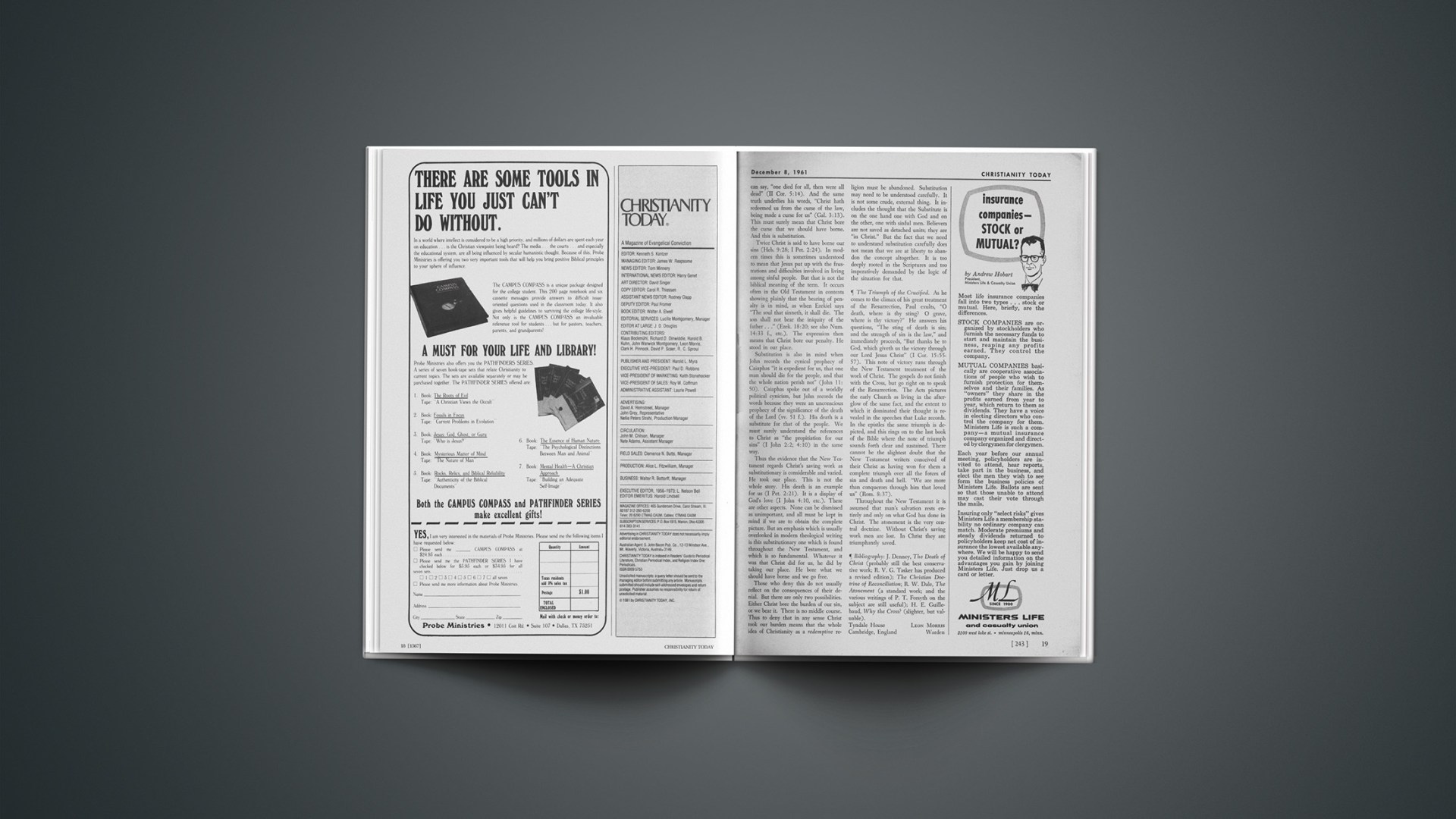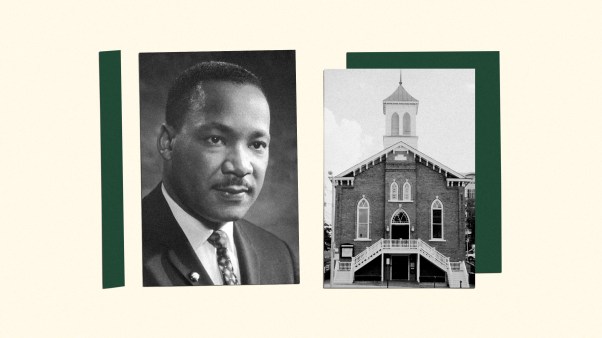When R. C. Moberley spoke of the Incarnation as “the crucial doctrine” of Christianity, his adjective completely gave his case away. “Crucial” is from the Latin crux, “a cross.” So whenever we say, “This is the crucial point” or “The crux of the matter is this,” our language means “just as the Cross is central to Christianity, so the point I am making is central to the present discussion.” The centrality of the Cross to the Christian faith has shaped the language we use.
Right at the heart of Christianity there is a cross, and on that cross the Son of God wrought man’s salvation. Put simply, the atonement means that Jesus Christ in his death dealt completely with the problem that man’s sin had set. Whatever had to be done, He did it, and now those who come in faith may enter into full salvation. Throughout the centuries there have been many theories current in the Church as to how this was done, and none of them has been able to command universal acceptance. This leads us to the conclusion that there is an essential mystery about the atonement so that men cannot know completely how it works. But there are some points that the Bible makes very clear and any satisfactory understanding of the atonement must reckon with them.
The Love of God. The first point to notice is that the atonement proceeds from the loving heart of God. In the best known text in the whole Bible we read that “God so loved the world, that he gave his only begotten Son, that whosoever believeth in him should not perish, but have everlasting life” (John 3:16). With this, accord the words of Paul: “God commendeth his love toward us, in that, while we were yet sinners, Christ died for us” (Rom. 5:8). This line of teaching could be traced through the whole of Scripture, for it is fundamental that the atonement takes place only because God’s love leads to it.
Notice that the passages we have cited do not speak of the love of Christ, which we would perhaps think more natural. It is the love of the Father that is seen in the Cross (the love of the Son is, of course, seen too, but that is not the point in the passages under discussion). This is important in that it shows us that our salvation comes to us with all the majesty of God the Father behind it. It is a divine work in the fullest sense. It is important also in that it shows us that in this work of salvation the Father and the Son are completely at one. Sometimes, with the very best motives in the world, theologians have given the impression that God the Father is a stern judge, just, it is true, but stern. He lays down his requirements, and when men do not reach them insists on punishment. Into that situation comes the loving Son who intervenes in such a way as to save men from their judge. This is not the scriptural teaching at all, and must unhesitatingly be dismissed as a caricature. The atonement takes place because God the Father loves us and makes provision in his Son for our salvation.
The Sin of Man. Paul gives as one of the fundamental pieces of the Church’s teaching (it had been given to him: he did not originate it), that “Christ died for our sins according to the Scriptures” (1 Cor. 15:3). This, too, is teaching that could be widely documented, for the early Church was sure that Christ’s death and man’s sin were closely connected. So frequently do we find the two linked that it is more or less a commonplace of New Testament teaching on the subject, and it could be passed over quickly were it not for the fact that in modern times the church has often lost sight of this altogether. Many think of Christ as a martyr, and of his death as taking place because he was not understood, or because his teaching was rejected, or for political reasons or the like. “Explanations” of this type are legion, and they make a strong appeal to many in our day. But they are out of keeping with the New Testament, There it is clear that, humanly speaking, Jesus could have avoided the Cross had he so chosen. But he did not so choose, for this was the divine way of dealing with sin.
Sometimes the New Testament speaks of Christ’s blood as shed “for the remission of sins” (Matt. 26:28). This same blood “cleanseth us from all sin” (1 John 1:7). Christ “purged our sins” (Heb. 1:3); he “bare our sins in his own body on the tree” (1 Pet. 2:24). And there are other expressions. Whatever had to be done about sin, he did it. And he did it perfectly and finally for “where remission of these is, there is no more offering for sin” (Heb. 10:18).
The New Testament witness is clear. The death of Jesus was connected with the sin of man. And the death of Jesus was the perfect atonement for man’s sin.
Penal Substitution. The way this is effected in the traditional evangelical statement of the position is by Christ’s bearing the penalty that sinners had incurred, by his taking their place. It is true that the New Testament never uses this term, but it is difficult to explain such a passage as Romans 3:21–26 any other way. Here Paul says that the Cross shows us the righteousness of God. His point is that the truth that God is righteous was in danger of being obscured because in earlier days God had not always exacted the penalty for sin. “Remission” in verse 25 (KJV) is better “passing over”; the meaning is that God had passed over men’s sins without punishing them; therefore he might appear not to be just. But in the light of the Cross, such an accusation can never be leveled again. What does this mean if it does not mean that the penalty of sin has been borne?
Substitution is to be found in many places. We see it in the saying of Mark 10:45, “The Son of man came … to give his life a ransom for many.” The expression lutron anti pollon expresses a substitutionary thought, as, indeed, does the whole saying, for the meaning is “Because Christ died the many do not.” Again, the agony in Gethsemane taken with the cry of dereliction (Mark 15:34) points to the same thing. Why should Jesus be in an agony as he contemplated death? He was no coward, and many lesser by far have faced death calmly, including not a few who have been in spired by him. It was not death as such that he feared, but the death that was the death of sinners, that death in which he should experience the horror of being foresaken by him who is of purer eyes than to behold evil (Hab. 1:13). Paul is surely referring to the same thing when he says that God “made him to be sin for us, who knew no sin” (2 Cor. 5:21). This identifies Christ in his death in the closest manner with the sinners. He died the death of sinful men. So Paul can say, “one died for all, then were all dead” (2 Cor. 5:14). And the same truth underlies his words, “Christ hath redeemed us from the curse of the law, being made a curse for us” (Gal. 3:13). This must surely mean that Christ bore the curse that we should have borne. And this is substitution.
Twice Christ is said to have borne our sins (Heb. 9:28; 1 Pet. 2:24). In modern times this is sometimes understood to mean that Jesus put up with the frustrations and difficulties involved in living among sinful people. But that is not the biblical meaning of the term. It occurs often in the Old Testament in contexts showing plainly that the bearing of penalty is in mind, as when Ezekiel says “The soul that sinneth, it shall die. The son shall not bear the iniquity of the father …” (Ezek. 18:20; see also Num. 14:33 f., etc.). The expression then means that Christ bore our penalty. He stood in our place.
Substitution is also in mind when John records the cynical prophecy of Caiaphas “it is expedient for us, that one man should die for the people, and that the whole nation perish not” (John 11:50). Caiaphas spoke out of a worldly political cynicism, but John records the words because they were an unconscious prophecy of the significance of the death of the Lord (vv. 51 f.). His death is a substitute for that of the people. We must surely understand the references to Christ as “the propitiation for our sins” (1 John 2:2; 4:10) in the same way.
Thus the evidence that the New Testament regards Christ’s saving work as substitutionary is considerable and varied. He took our place. This is not the whole story. His death is an example for us (1 Pet. 2:21). It is a display of God’s love (1 John 4:10, etc.). There are other aspects. None can be dismissed as unimportant, and all must be kept in mind if we are to obtain the complete picture. But an emphasis which is usually overlooked in modern theological writing is this substitutionary one which is found throughout the New Testament, and which is so fundamental. Whatever it was that Christ did for us, he did by taking our place. He bore what we should have borne and we go free.
Those who deny this do not usually reflect on the consequences of their denial. But there are only two possibilities. Either Christ bore the burden of our sin, or we bear it. There is no middle course. Thus to deny that in any sense Christ took our burden means that the whole idea of Christianity as a redemptive religion must be abandoned. Substitution may need to be understood carefully. It is not some crude, external thing. It includes the thought that the Substitute is on the one hand one with God and on the other, one with sinful men. Believers are not saved as detached units; they are “in Christ.” But the fact that we need to understand substitution carefully does not mean that we are at liberty to abandon the concept altogether. It is too deeply rooted in the Scriptures and too imperatively demanded by the logic of the situation for that.
The Triumph of the Crucified. As he comes to the climax of his great treatment of the Resurrection, Paul exults, “O death, where is thy sting? O grave, where is thy victory?” He answers his questions, “The sting of death is sin; and the strength of sin is the law,” and immediately proceeds, “But thanks be to God, which giveth us the victory through our Lord Jesus Christ” (1 Cor. 15:55–57). This note of victory runs through the New Testament treatment of the work of Christ. The gospels do not finish with the Cross, but go right on to speak of the Resurrection. The Acts pictures the early Church as living in the afterglow of the same fact, and the extent to which it dominated their thought is revealed in the speeches that Luke records. In the epistles the same triumph is depicted, and this rings on to the last book of the Bible where the note of triumph sounds forth clear and sustained. There cannot be the slightest doubt that the New Testament writers conceived of their Christ as having won for them a complete triumph over all the forces of sin and death and hell. “We are more than conquerors through him that loved us” (Rom. 8:37).
Throughout the New Testament it is assumed that man’s salvation rests entirely and only on what God has done in Christ. The atonement is the very central doctrine. Without Christ’s saving work men are lost. In Christ they are triumphantly saved.
Bibliography: J. Denney, The Death of Christ (probably still the best conservative work; R. V. G. Tasker has produced a revised edition); The Christian Doctrine of Reconciliation; R. W. Dale, The Atonement (a standard work; and the various writings of P. T. Forsyth on the subject are still useful); H. E. Guillebaud, Why the Cross? (slighter, but valuable).
Warden
Tyndale House
Cambridge, England










